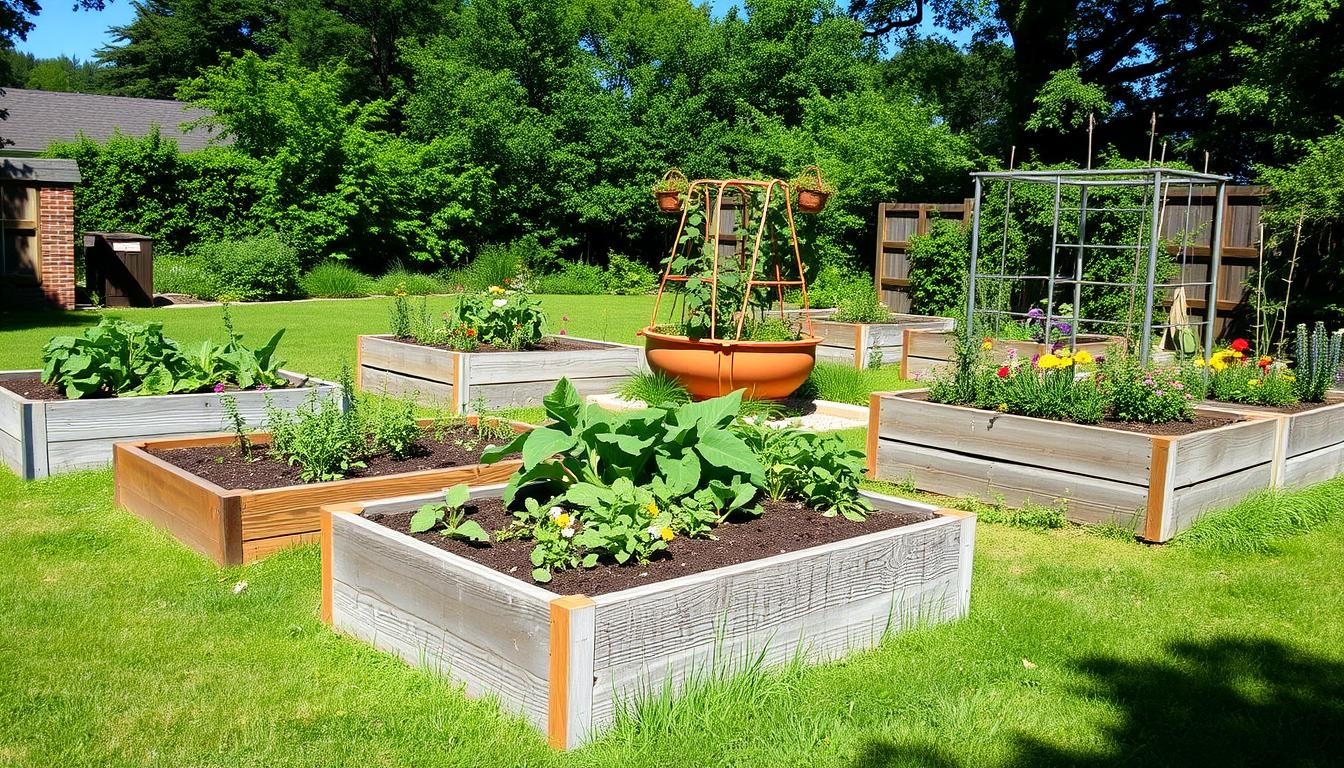Creating a beautiful and functional outdoor space is achievable through garden construction, focusing on raised beds. Raised garden beds offer numerous benefits, including better soil control and drainage. They are an ideal choice for garden design. With the right tools and materials, you can build your own raised garden beds, regardless of your gardening experience.
When it comes to garden construction, raised beds are a great option. They provide a controlled environment for your plants to thrive. With proper planning, they can be a stunning addition to your outdoor space. In this guide, we will walk you through every step of the way, from planning and designing your garden to constructing and maintaining it, focusing on raised beds and garden design.
Our goal is to provide you with a comprehensive guide to constructing raised garden beds. We cover all aspects of garden construction and design. Whether you’re a seasoned gardener or a beginner, this guide will help you create a beautiful and functional outdoor space.
Introduction to Raised Garden Beds
Raised garden beds are a great way to create a beautiful and functional outdoor space. With the right tools and materials, you can build your own. In this section, we introduced the benefits of raised garden beds and provided an overview of the construction process, focusing on garden construction and raised beds.
Key Takeaways
- Raised garden beds offer better soil control and drainage
- Garden construction can be a fun and rewarding experience
- Raised beds are a great option for garden design
- Proper planning is essential for a successful garden construction project
- Raised garden beds can be a stunning addition to your outdoor space
Understanding the Benefits of Raised Garden Beds
Raised garden beds provide a controlled environment for gardening. They allow for better soil preparation and optimal growing conditions. Constructing a raised garden bed creates a space perfect for vegetable gardens. It offers improved drainage and aeration, leading to healthier plants and increased crop yields.
Some of the key benefits of raised garden beds include:
- Improved soil control and drainage, reducing the risk of waterlogged soil and root rot
- Reduced back strain and easier access, making it ideal for gardeners with mobility issues
- Extended growing season, as the soil in raised beds warms up faster in the spring and stays warmer in the fall
When it comes to soil preparation, raised garden beds offer a unique opportunity. You can create a customized soil mix tailored to your plants’ needs. This mix can include topsoil, compost, and other amendments for a fertile and well-draining growing medium.
Raised garden beds also allow for various garden styles, from traditional vegetable gardens to decorative gardens with flowers and shrubs. With proper planning and construction, they can be a valuable addition to any gardening project.
Essential Planning and Site Selection
Creating a thriving garden starts with garden planning. This means looking at sunlight, soil quality, and accessibility. These factors ensure your raised garden bed thrives. Good garden design is also key to your garden’s success.
Choosing the right spot for your raised garden bed is crucial. Consider these factors:
- Sunlight: Most plants need at least 6 hours of direct sunlight daily.
- Soil quality: Test your soil to check its pH level and nutrient content.
- Accessibility: Make sure your garden bed is easy to reach for upkeep and harvesting.
By planning and picking the right spot, you can have a productive garden. It will give you fresh produce for years. Remember to use garden design to make the most of your space. With good garden planning, you’ll enjoy a fruitful harvest and a lovely outdoor area.
A well-planned garden is a happy garden. Take the time to consider your needs and your plants’ needs for a thriving outdoor space.
Choosing the Right Materials for Your Garden Beds
When constructing your garden, picking the right materials for raised beds is key. The material you select greatly affects the bed’s durability and performance. Wood beds, with their natural and rustic appeal, are a favorite. Yet, metal, stone, and composite materials also present viable alternatives.
Wood beds are durable but need more upkeep than other options. Metal and stone, by contrast, are more resilient and easier to maintain. Composite materials strike a middle ground, offering both durability and minimal upkeep.
Wood Options and Durability
Wood is favored for raised beds due to its natural charm. Cedar and recycled plastic wood stand out, boasting durability and resistance to rot and pests.
Alternative Materials: Metal, Stone, and Composite
Metal and stone provide a modern, sleek aesthetic for raised beds. Composite materials, a blend of various materials, offer a durable and low-maintenance solution.
Cost Comparison Guide
| Material | Cost | Durability |
|---|---|---|
| Wood | $50-$100 | 5-10 years |
| Metal | $100-$200 | 10-20 years |
| Stone | $200-$500 | 20-50 years |
| Composite | $100-$300 | 10-20 years |
The choice of material for your raised beds hinges on your budget, personal taste, and garden needs. By weighing the options and costs, you can make a well-informed decision. This will help you craft a stunning and practical garden space.
Required Tools and Equipment Checklist
For garden construction, the right tools and equipment are crucial for raised beds building and upkeep. A comprehensive toolkit ensures tasks are done efficiently and effectively. This leads to a thriving garden.
Begin with basic tools like shovels, hammers, saws, and drills. These are vital for digging, assembling, and fixing raised beds. Don’t forget safety gear, such as gloves and safety glasses, to safeguard against hazards.
Here’s a checklist for garden construction tools and equipment:
- Shovels and trowels for digging and planting
- Hammers and mallets for assembling and repairing
- Saws and drills for cutting and drilling materials
- Safety equipment, including gloves and safety glasses
- Measuring tapes and levels for ensuring accuracy
Having these tools ready prepares you for any garden construction task. Always use tools safely and effectively for the best raised beds results.
With the right tools and equipment, you can create a vibrant and productive garden in your raised beds. Enjoy your gardening journey!
| Tool | Description |
|---|---|
| Shovel | Used for digging and planting |
| Hammer | Used for assembling and repairing |
| Saw | Used for cutting materials |
Determining the Perfect Size and Height
In garden design, the dimensions of your raised garden bed are key. They affect both its functionality and ease of access. Standard sizes range from 4 to 8 feet wide and 6 to 12 feet long. The height can vary, but typically falls between 6 to 36 inches.
When planning your garden, accessibility is crucial. The bed’s height and the space between beds are important. A common guideline is to have at least 3 feet between beds for easy access. You can also use space-saving techniques like trellises or vertical planters to optimize your space.
Here are some key considerations for determining the perfect size and height for your raised garden bed:
- Soil depth: Ensure your bed is deep enough to accommodate the root systems of your plants.
- Accessibility: Consider the height and space between beds for easy maintenance and movement.
- Space optimization: Use trellises, vertical planters, or other space-saving techniques to maximize your garden’s potential.
| Bed Width | Bed Length | Bed Height |
|---|---|---|
| 4 feet | 6 feet | 6 inches |
| 6 feet | 8 feet | 12 inches |
| 8 feet | 12 feet | 18 inches |
By considering these factors and incorporating them into your garden design and garden planning, you can create a raised garden bed that is both functional and accessible. This will allow you to enjoy a thriving and productive garden.
Step-by-Step Construction Process
Building raised beds is a fantastic approach to garden construction. It’s a straightforward process that can be done with basic tools. This method is ideal for creating a vibrant garden space.
To begin, clear the area of debris and level the ground. This step is crucial for ensuring your raised bed is stable and even. Then, construct the frame using materials like wood or composite.
Here are the basic steps to follow:
- Prepare the site and assemble the frame
- Attach the bottom and sides of the raised bed
- Fill the bed with a mix of soil and compost
When planning your garden construction, consider the size and height of your raised bed. A typical size is 4×8 feet, but you can adjust it to suit your space. These simple steps will help you build a beautiful, functional raised bed for your garden.
By following these steps and choosing the right materials, you can create a thriving garden with your new raised beds. Enjoy your gardening journey!
Proper Soil Preparation and Filling Methods
Creating a thriving garden starts with soil preparation. In raised garden beds, the soil is the foundation. It’s essential to understand the importance of proper soil preparation and filling methods for optimal results.
A well-structured soil mixture is vital for plant growth. The ideal mixture includes topsoil, compost, and perlite or vermiculite. This blend provides nutrients, drainage, and aeration for roots to grow. Testing the pH level of your soil and adjusting it for your plants’ needs is crucial in soil preparation.
Soil Mixture Ratios
- 60% topsoil
- 20% compost
- 20% perlite or vermiculite
Creating a layered structure in garden beds is also important. This involves layering soil, compost, and organic matter. Following these guidelines helps create a thriving garden in your raised garden beds.
Drainage Solutions
Proper drainage is key to prevent waterlogged soil and root rot. Adding a layer of gravel or broken pottery at the bottom of your garden beds helps. It ensures excess water drains away from the roots, promoting a healthy garden.
| Soil Component | Percentage |
|---|---|
| Topsoil | 60% |
| Compost | 20% |
| Perlite or Vermiculite | 20% |
Installing Irrigation Systems
In garden construction, the irrigation system is crucial. It ensures soil moisture levels in raised beds are optimal. This reduces water waste and guarantees plants get the right water amount.
For raised beds, an irrigation system is highly beneficial. Here are some key points to consider:
- Reduced water waste: An irrigation system delivers water directly to the roots, cutting down on evaporation and runoff.
- Increased efficiency: These systems can be set to water plants at the best time, eliminating the need for manual watering.
- Improved plant health: Consistent soil moisture prevents overwatering and underwatering, which harm plants.
Choosing the right irrigation system for raised beds is essential. Options include soaker hoses, drip irrigation, and sprinkler systems. Consider water pressure, flow rate, and coverage area to pick the best system for your garden.
Installing an irrigation system in raised beds leads to a healthier, more productive garden with less water waste. Ensure your system matches your garden’s specific needs.
| Irrigation System | Benefits | Considerations |
|---|---|---|
| Soaker Hoses | Reduced water waste, easy to install | May not be suitable for large gardens |
| Drip Irrigation Systems | High efficiency, customizable | May require more maintenance than other systems |
| Sprinkler Systems | Covers large areas, easy to install | May waste water due to evaporation and runoff |
Adding Features to Your Garden Beds
The realm of garden design is vast and exciting. After building your raised garden bed, you can introduce various elements to boost its functionality and beauty. It’s essential to plan your garden meticulously, focusing on its overall look and feel.
Consider adding trellises and support structures for climbing plants. This not only adds visual appeal but also maximizes space. For pest control, you can use fine mesh or copper tape to safeguard your plants.
Some notable features to think about in your garden planning include:
- Trellises and arbors for climbing plants
- Pest protection options, such as fine mesh or copper tape
- Decorative elements, such as garden statues or bird baths
By integrating these elements into your garden design, you can craft a stunning and practical outdoor area that mirrors your personal taste. Ensure your garden planning aligns with your design goals, selecting features that enhance your overall vision.
| Feature | Purpose | Benefits |
|---|---|---|
| Trellises and support structures | Provide framework for climbing plants | Maximizes space, adds visual interest |
| Pest protection options | Prevent pests from damaging plants | Protects plants, reduces maintenance |
| Decorative elements | Enhance aesthetic appeal | Creates a welcoming outdoor space |
Seasonal Maintenance Guidelines
To ensure your raised garden beds flourish, regular maintenance is crucial. This entails preparing your bed for each season, which includes soil preparation, pruning, and pest control.
Here are some seasonal maintenance tips:
- Spring: Add fresh soil and fertilizers to your garden beds to promote healthy plant growth.
- Summer: Ensure proper watering and mulching to retain moisture and suppress weeds.
- Fall: Clean up your garden beds, removing dead plants and debris, and add a layer of compost to prepare for the next season.
- Winter: Protect your garden beds from extreme temperatures and moisture by covering them with a layer of straw or burlap.
By adhering to these seasonal maintenance guidelines, you can maintain your garden beds’ appearance and ensure a bountiful harvest. Always prioritize soil preparation and care for your garden beds throughout the year.
With the right care and attention, your raised garden beds will provide you with fresh produce and beautiful flowers for years to come.
| Season | Maintenance Tasks |
|---|---|
| Spring | Soil preparation, fertilization, pruning |
| Summer | Watering, mulching, pest control |
| Fall | Cleaning, composting, bed preparation |
| Winter | Bed protection, straw or burlap covering |
Common Construction Mistakes to Avoid
In garden construction, avoiding common mistakes is key for a successful garden. A well-built raised bed offers better soil control, drainage, and reduced back strain. Yet, construction errors can cause issues like poor drainage and structural problems.
The choice of materials for raised beds greatly affects the garden’s quality and longevity. Material selection errors are common, where the wrong wood or materials are used. This can lead to durability issues and health risks for plants.
Design Flaws and Installation Pitfalls
Design mistakes, like inadequate root space or poor drainage, can harm raised beds. Installation errors, such as bad soil prep and wrong irrigation setup, can cause waterlogged soil and root rot. To sidestep these, careful planning and a structured construction process are crucial.
Here are some key considerations for avoiding common mistakes in raised bed construction:
- Choose the right materials for your raised beds, considering durability, sustainability, and cost.
- Design your raised beds with adequate space for roots to grow and with proper drainage systems in place.
- Follow a step-by-step construction process, ensuring each component is correctly installed and functioning as intended.
By understanding these potential pitfalls and taking steps to avoid them, you can create a thriving raised bed garden. Enjoy the many benefits that garden construction and raised beds offer.
| Mistake | Consequence | Prevention |
|---|---|---|
| Material selection errors | Poor durability, health risks | Choose durable, sustainable materials |
| Design flaws | Poor drainage, root growth issues | Plan for adequate space and drainage |
| Installation pitfalls | Waterlogged soil, root rot | Follow a structured construction process |
Conclusion: Growing Success with Your Raised Garden Beds
Starting your raised garden bed journey requires careful planning, proper construction, and diligent care. This guide has outlined the necessary steps to create a lush, productive garden bed. It promises to bring joy and satisfaction for years.
Begin with a solid plan, choosing the right location and materials for your garden beds. Paying attention to detail during construction ensures your beds are sturdy and tailored to your needs. Proper soil preparation and irrigation systems enhance your garden’s health and productivity.
As you grow your own produce, herbs, and flowers, stay vigilant in seasonal maintenance. Be proactive in addressing any issues that may arise. With patience, dedication, and a bit of green thumb magic, your raised garden beds will flourish. They will provide you with a bountiful harvest and a deep sense of accomplishment.


